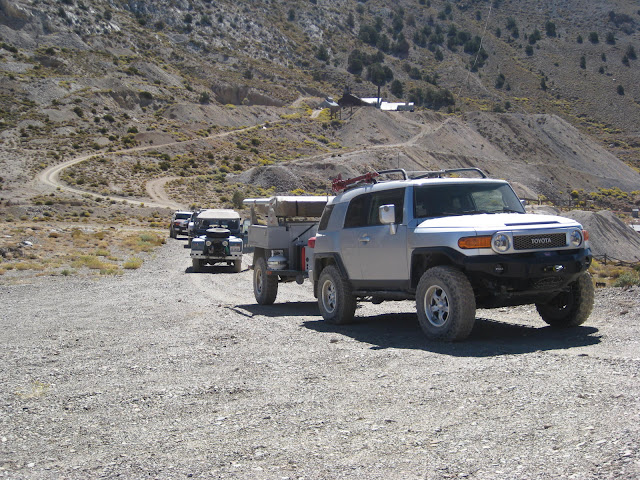Saturday was the second day of our "big" adventure. After breaking camp in the morning we zoomed back across the desert towards Manzanar. About half of the group needed more ice (beer was in danger of warming!!) and they stopped in Lone Pine. The other half parked along the highway near the visitor center at the junction of 395 and 136. Soon we were all together again and made the turnoff at Keeler to head up towards Cerro Gordo.
Here is Dave coming up one of the grades. Both he and I felt the extra weight of our trailers on the steeper uphills.
We made a short stop just above Cerro Gordo, partly because I started a wrong turn at the split. Doh! The stop also provided a brief respite for Da Snork's spunky little diesel engine. Yeah, I planned that!
Before long we had completed the traverse of the shelf road. It is always a great road for inspiring first timers to practice clenching their seat with their posteriors and digging their nails into their rig's grab bars. We parked at a nice spot near our first hike which would take us along the old water line that supplied Cerro Gordo.
This hike is maybe a one mile traverse that ambles by a nicely constructed two room mountainside "residence" for the man who probably kept the pump house in order. Some interesting artifacts can be seen there too. Then we hiked on to the remains of the pumphouse and finally a horizontal mine shaft that bores straight in for a quarter mile.
I've made this hike before but as always when traveling with a lively group, I learned that someone else could be more observant and a better thinker than I had been. Sigh. On previous hikes on the trail I had seen some T-shaped metal bars sticking out of the ground and thought that they were supports for the water lines.
Kevin (The Observant One) noticed something else and reached a far more accurate conclusion. He offered that these pieces of pipe jutting out of the slope below each of the T-bars were "connected".
Kevin's conclusion was that the T-bars were attached to valves that would be used to drain the buried water pipeline in preparation for winter's freezing temperatures. This piece of pipe in the picture was the drain pipe.
Way to go Kevin!
Here is a shot of one of the sketchier portions of the trail.
And here are some shots of one of the better preserved and reinforced portions of the pipeline trail
Men with black shirts and tan pants standing at the pumphouse. Very suspicious.....
 |
| Thank you to Eric for this photo! |
Next we drove our rigs further along the dirt road to get to Mexican Springs. Along the way we came to the steep uphill set of turns that had 10 inches of loose dirt and rock and I found that the weight of my trailer was enough to bog me down. My rear ARB locker is out of order so I came to a standstill, effectively blocking the whole group from further progress. OOPS! Backing up was a pain as the front wheels just slid without biting and neutralized my steering, letting the trailer start an unwanted turn. The whole gang grabbed a hold of my trailer and manually steered it back down the trail. Bill went ahead with his FJ Cruiser and we hooked up a strap. He toggled his E-Locker on and gave me the tugs that I needed to easily make it up. Everyone else made it up just fine after that, especially Dave made it up with no asisstance while pulling his trailer.
Mexican Springs has long been on my list and I'm glad we took the time as I've driven by it so many times before. The exterior is nothing special but the details are fascinating. This and the previous hike's buildings may have been prefabricated based on some of the markings that we observed on the sheet metal.
The pump really was steam powered and the boiler designs are quite interesting. I don't know why there were so many of them on location, at least 3 so maybe they wore out? This pump house is said to be somehow connected to Mortimer Belshaw who built the "Yellow Grade" toll road from Keeler to Cerro Gordo.
There were interesting and cryptic pencilled notes on the walls.
Also lots of other cool but rusty machinery
Before we made the hike back up to our vehicles Linus seemed to be just absorbing what was left of the pumphouse, maybe imagining the noise and the clatter that surely echoed off of the canyon walls so many years ago.

























































